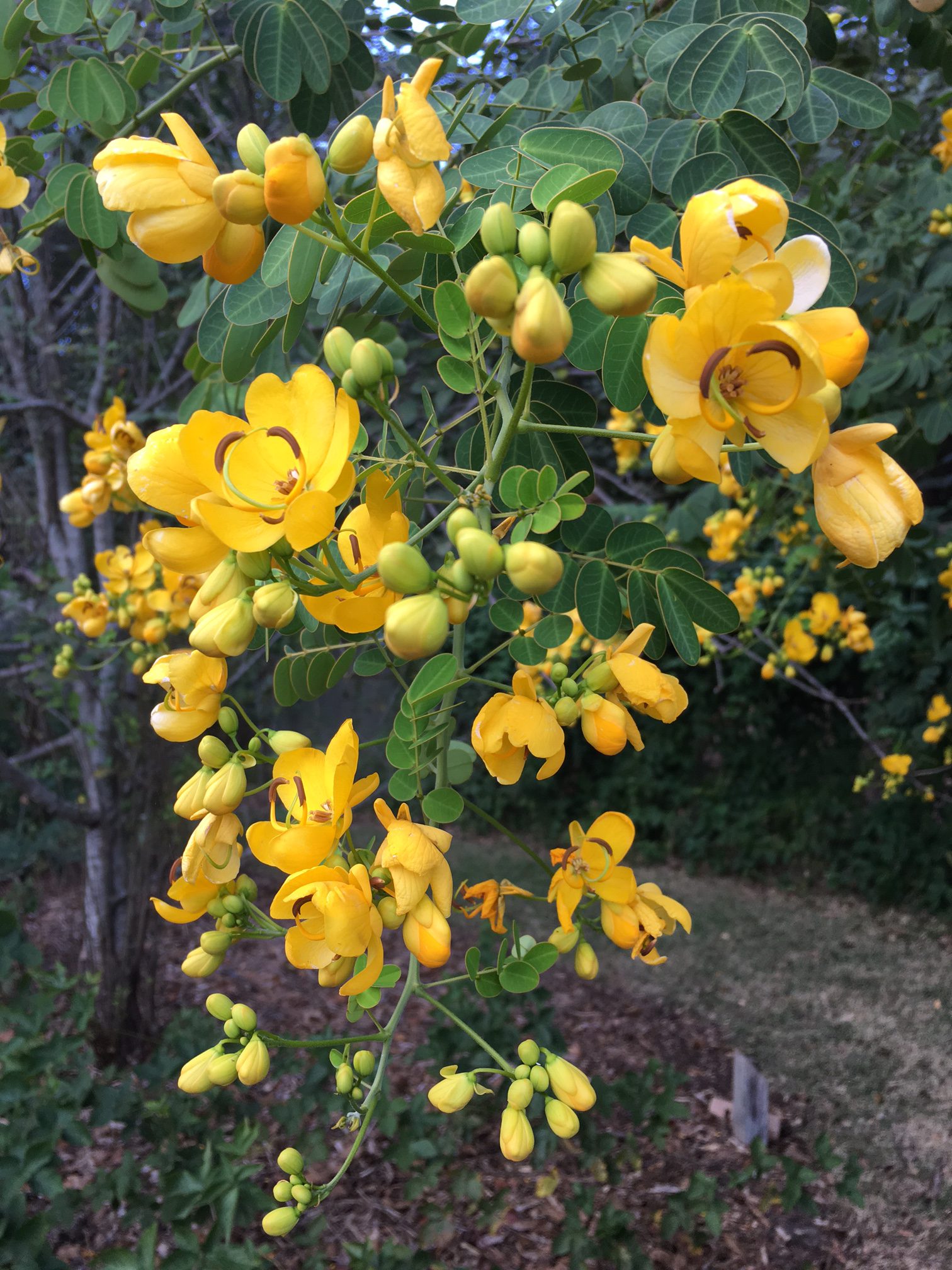
by Mary Salinas | Nov 7, 2016
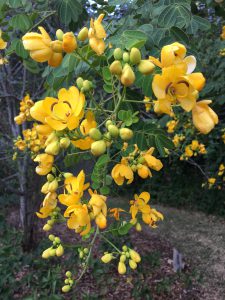
Photo credit: Mary Derrick, UF/IFAS Extension.
When many of our summer blooming plants start fading, yellow cassia, Senna bicapsularis, becomes a show stopper. Late fall and early winter is when it blooms and dazzles. The bright yellow flowers appear in numerous clusters at the tips of this many branched shrub. This makes for a stunning display in sunny areas of the landscape.
Yellow cassia grows to 8 to 12 feet in height and at least twice that in width. In the panhandle it often freezes back when we have a harsh winter. If that happens, prune it to the ground and it will come back the following spring and regain its previous size and beauty by late fall when it is ready to bloom. An advantage is that it is moderately drought and salt tolerant.
The flowers are attractive to bees for pollen although they are not attractive to butterflies as the flowers don’t produce much, if any, nectar. Yellow cassia serves as a host plant for some lovely butterflies. The cloudless sulphur, orange-barred sulphur and the sleepy orange all use cassia to rear their caterpillars. The shrub will rarely be heavily affected by a little herbivory from their caterpillars and will recover to bring you a stunning display the following year.
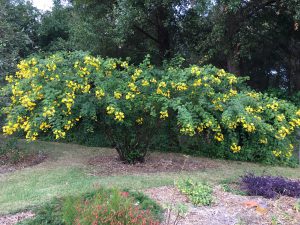
Photo credit: Mary Derrick, UF/IFAS Extension.
If you purchase a yellow cassia, check out the botanical name. Senna bicapsularis is what you want and not Senna pendula var. glabra which is a listed invasive plant species for central and south Florida.
For more information on Florida gardening:
UF/IFAS Gardening Solutions

by Mary Salinas | Sep 22, 2016
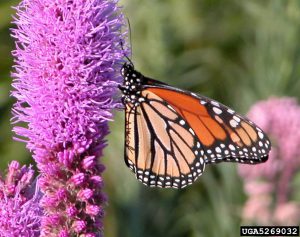
Monarch butterfly on dense blazing star (Liatris spicata).
Beverly Turner, Jackson Minnesota, Bugwood.org
The Florida panhandle has a treasure of native wildflowers to enjoy in every season of the year. In the late summer and fall, blazing star, also commonly known as gayfeather, can be found blooming in natural areas and along roadsides. You can also add it to your landscape to provide beautiful fall color and interest year after year.
Blazing star is a perennial that is native to scrubs, sandhills, flatwoods and upland pines; this makes it a tough plant that can endure drought conditions once it is established. It is ideal for a low-maintenance landscape and is a perfect addition to a butterfly or pollinator garden. The butterflies and bees love it!
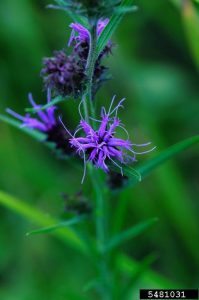
Scaly blazing star (Liatris squarrosa). Photo credit: Vern Wilkins, Indiana University, Bugwood.com.
This beauty grows tall and slender so it is best when planted in masses for an impressive display. This lankiness can result in lodging, or falling over, when the blooms get too heavy but this can be alleviated when grown in masses or with other wildflowers that can support them. The spent flowers will provide your garden with more seed for future years and form a larger colony.

Chapman’s Blazing Star (Liatris chapmanii). Photo credit: Mary Derrick, UF/IFAS.
The home gardener can add blazing star as potted plants or by seeding directly into the soil in October in north Florida. Seeds are available from numerous online sources. Before you purchase, however, make sure that the species you select is a Florida native!
For more information and seed sources:
Florida Wildflower Foundation
Common Native Wildflowers of North Florida
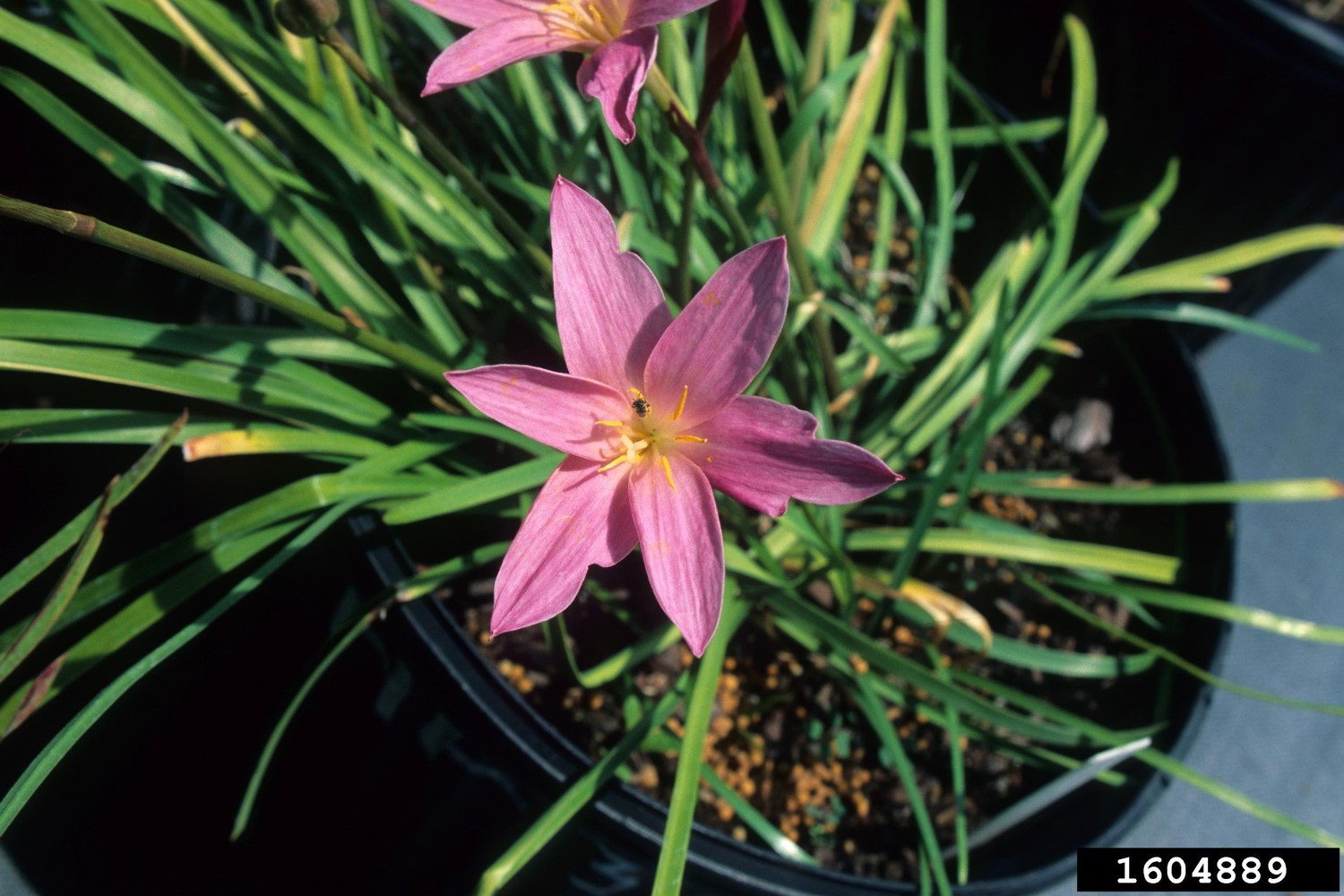
by Mary Salinas | Sep 2, 2016
Florida is home to many gorgeous and desirable native plant species. One to consider for your landscape is the rainlily, Zephyranthes and Habranthus spp. They are easy to care for and are bothered by few pests.
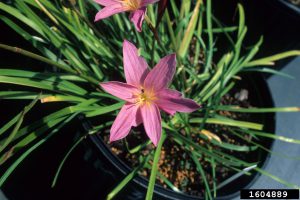
Cuban rainlily, Zephyranthes rosea. Photo: John Ruter, University of Georgia, Bugwood.org
As the name implies, rainlilies do thrive when getting consistent rain or watering. A good soaking rain event will result in blooms within a few days. This love for moisture makes them perfect for rain gardens.
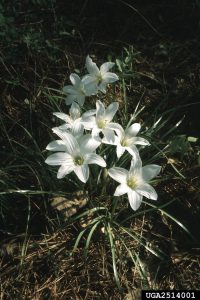
Atamasco rainlily, Zephyranthes atamasco. Photo: Jerry A. Payne, USDA Agricultural Research Service, Bugwood.org.
Plant the bulbs or transplants in full sun to part shade in moist but well-drained fertile soil. Let them be for many years in order to form large impressive clumps and that is when they flower the best. You can also separate the clumps every few years to colonize new areas and pass along to others. After the plants bloom they will reliably set seed that you can collect to start rainlilies in other parts of your garden. However, the seeds are viable for only a short time so you should plant them immediately.
For sources of plant material, try your local nursery that tends to carry native plants or through online sources.
For more information:
Rainlily, Zephyranthes and Habranthus spp.: Low Maintenance Flowering Bulbs for Florida Gardens
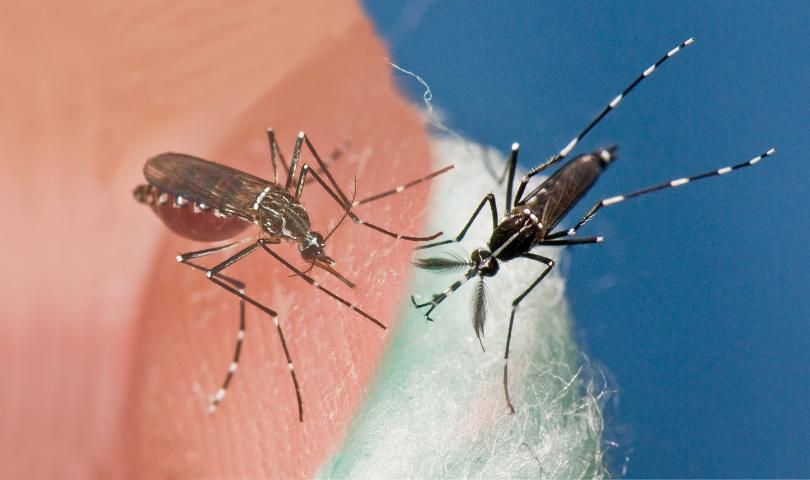
by Mary Salinas | Jul 7, 2016
The Zika virus has made us all more aware of the need to avoid getting bit by mosquitoes when we travel to those destinations that have confirmed reports of Zika infected mosquitoes. The Centers for Disease Control and Prevention lists the countries and territories that have travel notices to consult prior to planning a trip or traveling.
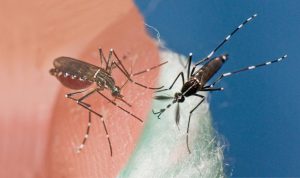
The invasive mosquitoes Aedes aegypti (left) and Aedes albopictus (right) occur in the Americas, including Florida, and have been implicated in the transmission of Zika virus.
Credit: J Newman, UF/IFAS/FMEL
The Florida Department of Health has recommendations for preventative action to take when traveling to any location that has confirmed Zika virus.
- You should use an insect repellant (following all label instructions) with any of these active ingredients:
- DEET
- Picaridin
- Oil of lemon eucalyptus
- Para-menthane diol
- IR3535
- Wear long-sleeved shirts and pants
- Wear clothing that is pre-treated with permethrin or apply a permethrin product to your clothes, but not your skin!
- Avoid getting bitten while you sleep by choosing a place with air conditioning or screens on windows and doors or sleep under a mosquito bed net.
According to the Georgia Department of Public Health you should also protect yourself against mosquito bites for at least a week after you return home from any location that has confirmed Zika. You may have an active infection without symptoms that can be spread to others through mosquito bites.
Now let’s talk about mosquito control in your own landscape.
Even though we don’t have confirmed Zika infection in Florida mosquitoes at this writing, mosquitoes in our state can transmit other diseases such as: eastern equine encephalitis, dengue fever, dog or cat heartworm, chikungunya, malaria, St. Louis encephalitis and west Nile virus.
Let’s first explore what kind of environment in your landscape and around your home is friendly to the proliferation of mosquitoes. Adult mosquitoes lay their eggs on or very near water that is still or stagnant. That is because the larvae live in the water but have to come to the surface regularly to breeze. The small delicate larvae need the water surface to be still in order to surface and breathe. Water that is continually moving or flowing inhibits mosquito populations.
Look around your home and landscape for these possible sites of still water that can be excellent mosquito breeding grounds:
- bird baths
- potted plant saucers
- pet dishes
- old tires
- ponds
- roof gutters
- tarps over boats or recreational vehicles
- rain barrels (screen mesh over the opening will prevent females from laying their eggs)
- bromeliads (they hold water in their central cup or leaf axils)
- any other structure that will hold even a small amount of water (I even had them on a heating mat in a greenhouse that had very shallow puddles of water!)
You may want to rid yourself of some of these sources of standing water or empty them every three to four days. What if you have bromeliads, a pond or some other standing water and you want to keep them and yet control mosquitoes? There is an environmentally responsible solution. Some bacteria, Bacillus thuringiensis ssp. israelensis or Bacillus sphaericus, only infects mosquitoes and other close relatives like gnats and blackflies and is harmless to all other organisms. Look for products on the market that contain this bacteria.
For more information:
Zika, a Mosquito-Transmitted Virus
Mosquito Repellents
UF/IFAS Mosquito Information Website
Florida Container Mosquitoes
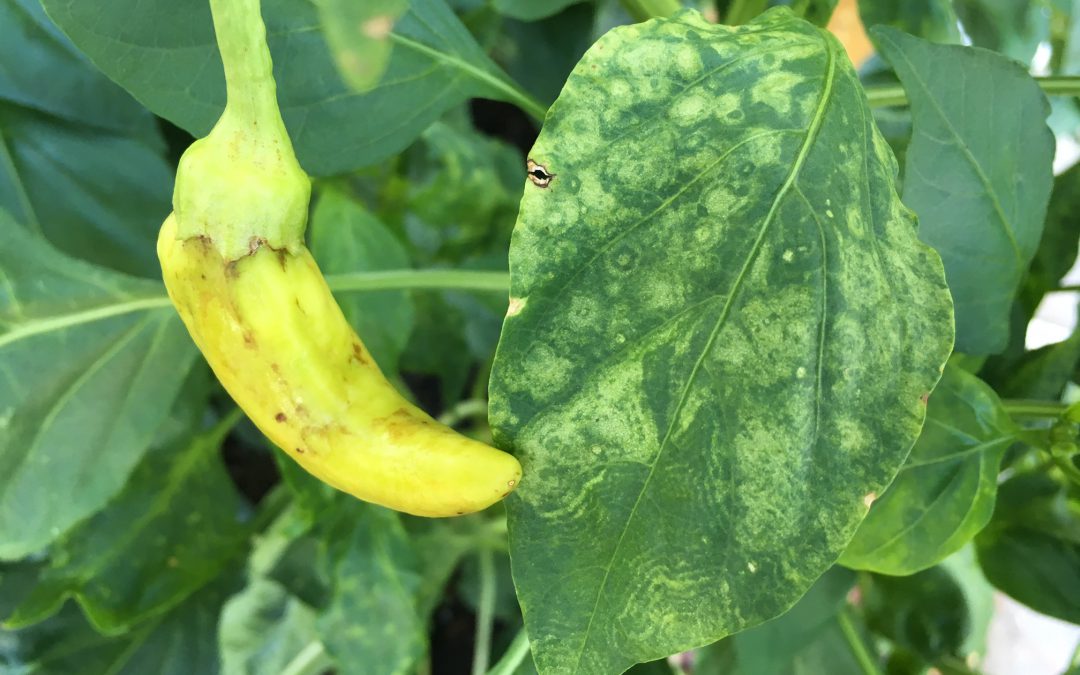
by Mary Salinas | Jul 7, 2016
Peppers and tomatoes are in the same plant family – solanaceae or more commonly known as the nightshade family – and can be susceptible to some of the same diseases. This is true of Tomato Spotted Wilt Virus (TSWV). The solanaceae family includes potatoes, eggplant, tobacco, petunia, tomatillo and deadly nightshade in addition to pepper and tomato.
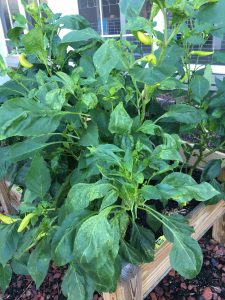
Pepper with TSWV. Photo credit: Mary Derrick, UF IFAS Extension.
This virus is spread by very small insects known as thrips. They acquire the virus as larvae when feeding on an infected plant and then transmit the disease when they fly to other susceptible plants as adults.
Initial symptoms are yellowing and distortion of the leaves. The leaves can also display yellow or brown circular ring spots. The severity of the virus can depend on the particular cultivar of pepper, its age and the environmental conditions in which the pepper is growing. Fruit can develop yellow, brown or ring spots as well.
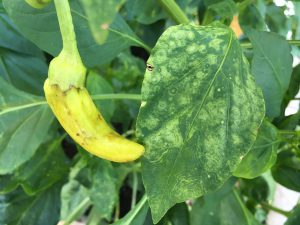
TSWV infection showing ring spot on leaves and lesions on fruit. Photo credit: Mary Derrick, UF IFAS Extension.
If you think your pepper has TSWV, consult your local extension agent to confirm the diagnosis. But once infected, there is no treatment for the plants and they should be pulled up and disposed of in the trash to prevent other susceptible plants from becoming infected.
For more information:
Some Common Diseases of Pepper in Florida















